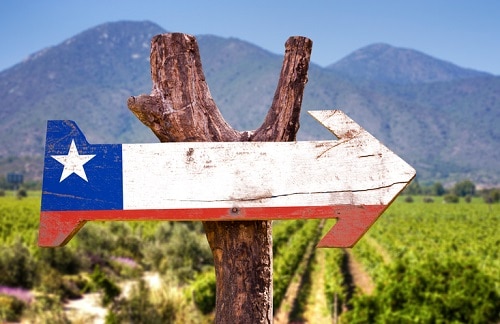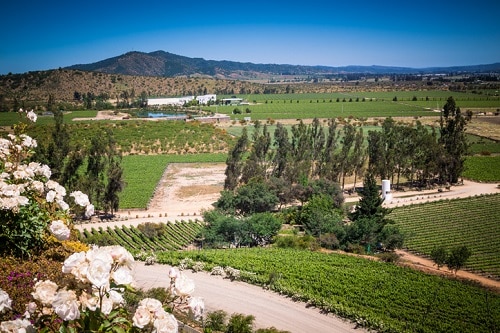Discover Chile’s Wine Country
Last Updated on June 4, 2023.
Once thought of only as an exporter of economical wines, Chile’s global wine reputation has significantly improved over the past 30 years as vinification techniques have modernized, new grapes have been introduced, and political instability subsided, leading to an increase in the overall quality of exports. Now, the country is a hub for organic, biodynamic, and sustainable winemaking due to its relatively dry climate and farming practices.
A Brief History Lesson on Chilean Wine
Though it’s considered a “New World” country, Chile’s winemaking history extends back to the 16th century when Spanish conquistadors brought vines from Spain to plant in their new land. Throughout its history of winemaking, Chile has been a lucky country owing to its lack of vine pests and diseases as a result of its isolation between the Andes Mountains and the Pacific Ocean.
When the world was fighting phylloxera at the end of the 19th century, Chile’s vineyards were protected by its geographic position on the globe. It’s a country with warm, dry summers, 2,700 miles of coastline, and regular water supply from melted snow off the Andes mountains that run the spine of the country along the eastern border.
Up until the early 1990s, there were only about 10 wine-producing families in the country. Now, this number is much higher as the industry has seen a massive expansion over the past 30 years. Chile is now the fifth largest exporter of wine in the world and the seventh-largest producer.
Chile’s Grape Varieties and Wine Styles
Chile produces wine across the spectrum of styles, including Red, White, Sparkling, Rosé, and even some sweeter dessert wines. Most dry wines out of Chile are distinguishable by their fruit-forward and herbaceous characteristics existing simultaneously in the glass.
Popular grape varieties found in Chile are Cabernet Sauvignon, which is the most widely planted across the country; Chardonnay; Sauvignon Blanc, which is usually riper than its French cousins in Bordeaux; Syrah, Pinot Noir, and Carménère. Chile grows 98% of the world’s Carménère, and it has become a grape that is practically synonymous with Chilean wine production.
What makes Chile unique as a wine-producing country is its ability to produce wines of high quality for a good value. In addition to the economical exports from the country, Chile’s wines of quality are also usually priced very well in the market. Quality brands such as Montes Purple Angel and Don Melchor are priced competitively compared to wines of equal quality coming out of other countries and regions around the world.
Chilean Wine Regions
Overall, there are 800 miles from the northern-most wine region of Atacama to the Bio-Bio region in the south. The main vineyards are found between the latitudes of 32-38 degrees, which is equivalent to southern Spain and northern Africa, but Chile’s climate is much more temperate than its European counterparts thanks to the influence of the cooler Pacific Ocean, making it easier to produce quality wines over a large portion of the long country.
Chile uses a Denomination of Origin (D.O.) system. The main regions are broken down into sub-regions and then also more specific zones.
The terrain is also extremely important in Chile, as the vineyards can be found in several different types of geographic locations. In addition to the D.O. system, Chilean wine can be further broken down into terrain-based categories. The three categories are Costa (coastal), Entre Cordilleras (mid-mountain range), and Andes (Andes mountains).
Chilean Viticultural Areas
At the northern end of the wine-producing area of Chile is the Atacama Region. The Atacama Region is most known for its Pisco and table grapes. It is an extremely hot and dry region as it is home to the Atacama Desert. The region is split into two valleys, the Copiapó and Huasco.
Just south of the Atacama Region is the Coquimbo Region with three wine-producing sub-regions: Elqui, Limarí, and Choapa. The Choapa Valley Region is mostly known for pisco and is the narrowest part of the entire country. Elqui Valley is about 330 miles north of Chile’s capital of Santiago, and the Limarí Valley is 290 miles north of the main city. The climate in the Limarí region is similar to Marlborough in New Zealand making it a great spot to grow Chardonnay, Sauvignon Blanc, and Pinot Noir.
Next is the Aconcagua Valley Region, which is home to the Aconcagua Valley, Casablanca Valley, and the small region of the San Antonio Valley. The Casablanca region is a cooler region that is most known for its white wines such as Chardonnay and Sauvignon Blanc, as well as Pinot Noir.
The Central Valley Region is perhaps the best known due to its proximity to Santiago. It is also the region that is most productive for producing wine. The Central Valley is made up of four sub-regions: the Maipo Valley, Rapel Valley, Curicó Valley, and Maule Valley.
The Maipo Valley is the closest to Santiago. The Rapel Valley is one of the largest wine-producing regions by production numbers in the Central Valley. It is also home to the sub-regions of the Cachapoal and Colchagua Valleys, the latter of which is one of the more famous regions across the globe.
The Curicó and Maule Valleys are both south of Santiago by 120 and 160 miles, respectively. The Maule Valley is one of the country’s oldest wine-producing regions and also one of the largest in the country. It is best known for its powerful Cabernet Sauvignon and spicy Carménère.
In southern Chile, there are three main sub-regions, which include the Bio Bio Valley, the Itata Valley, and the Malleco Valley. This region is known mainly for its jug wines, although some producers have experimented with cooler climate grapes here. The Itata and Malleco Valleys are smaller and still developing, however, the Bio-Bio Valley is known now for crisp, aromatic Pinot Noir, Chardonnay, and Sauvignon Blanc.
Chilean Wineries
Chilean wines have gained international recognition as wines of quality, especially in the 21st century. In 2004 at the Berlin Wine Tasting, two Cabernet-based Chilean wines took first and second place after blind review by a panel of 36 European experts who tasted through top wines from France, Italy, and Chile. The winning wines were Viñedo Chadwick 2000 and Sena 2001. In the following years of that competition in Brazil and Tokyo, Chilean wines continued to rank in the top wines.
Top Chilean Producers of Note
Viña Concha y Toro-one of the largest growers in the country and owner of the Casillero del Diablo brand.
Don Melchor-was once Concho y Toro’s premium label, but now is its own entity. Don Melchor was one of the original icon wines in Chile.
Viña Montes-one of the first premium producers in the country. Top wines include Montes Alpha “M” and Purple Angel, as well as the Montes Classic Series.
Cono Sur-a modern winery focused on the use of technology to produce quality wine at value prices with respect for the environment.
Viña Los Vascos (Domanies Barons de Rothschild (Lafite))- the infamous French family took over the Los Vascos estate in 1988 and has been committed to producing both economical and premium New World wine with Old World experience.
If you’re interested in visiting Chilean wine country, see below to browse Winetraveler’s directory of wineries to visit in many of these regions.
Written By Jacqueline Coleman
Jacqueline Coleman is a professional wine writer, certified sommelier, wine judge and consultant based in Miami, FL.


